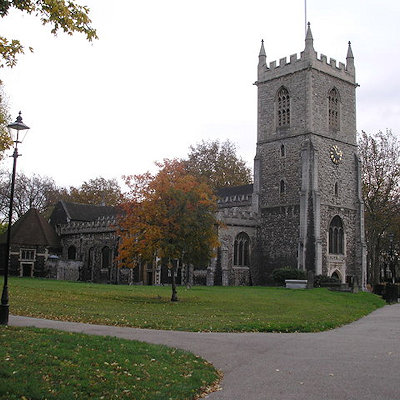
Like us on Facebook
PLACE NAMES


 
|
|
Stepney
|

|
|
|
As with most of the East End of London, Stepney was sparsely populated marshland until the 19th century, when the development of London's docks and railways, combined with slum clearance, pushed the displaced poor and various immigrants looking for work into cheap housing being built in the area.
The first community developed around the church of St Dunstan's, which was founded in 923. Its name was recorded around 1000 AD as Stybbanhyð, "Stybba's landing-place". The Domesday Book survey of 1086 gives the name as Stibanhede and says that the land was held by the Bishop of London and was 32 hides large, mainly used for ploughing, meadows, woodland for 500 pigs, and 4 mills. There were over 100 serfs, split between villeins who ploughed the land, and cottars who assisted the villeins in return for a hut or cottage.
Bishop William held this land in demesne, in the manor of Stepney, on the day on which King Edward was alive and dead. In the same vill Ranulph Flambard holds 3½ hides of the bishop.
The Manor of Stepney was held by the Bishop of London in compensation for his duties in maintaining and garrisoning the Tower of London. Further ecclesiastic holdings came about from the need to enclose the marshes and create flood defences along the Thames. Edward VI passed the land to the Wentworth family, and thence to their descendants, the Earls of Cleveland. The ecclesiastic system of copyhold, whereby land was leased to tenants for terms as short as seven years, prevailed throughout the manor. This severely limited scope for improvement of the land and new building until the estate was broken up in the 19th century.
In the early 20th century, Stepney was one of the most Jewish neighbourhoods in England; it was eventually replaced by Stamford Hill.
The Siege of Sidney Street took place in Stepney in 1911.
Stepney Green developed as a street of residential housing off the Mile End Road in the 15th century, and is now a conservation area. A brewery was founded in 1738 that developed into Charrington and Co. in 1897. The brewery building, the Anchor Brewery, was on the north side of Mile End Road, opposite Stepney Green; and is now the site of the Anchor Retail Unit, owned by Henderson Global Investors, though the Brewery Offices still remain on the corner of Mile End Road and Cephas Avenue.
St Dunstan's, founded in 923, is Stepney's oldest church. The present building dates principally from the 15th century. St Dunstan's has a long association with the sea, being responsible for registration of British maritime births, marriages and deaths until the 19th century. Malplaquet House is a Grade II listed building.
Stepney City Farm has been a feature in Stepney since opening as Stepping Stones Farm in 1979. A community resource, the farm aims to provide the people of East London a chance to experience rural life and engage in educational, environmental and creative projects. Stepney City farm is home to donkeys, cows, goats, pigs, sheep, ducks, geese, chickens, rabbits, ferrets and guinea pigs. As a working farm, eggs and vegetables are regularly sold.
|
 Feel free to Email me any additions or corrections Feel free to Email me any additions or corrections
LINKS AVAILABLE TO YOUR SITE
| |





